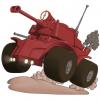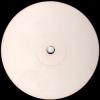heavy revolver having better penetration than an assault rifle? most revolvers having the same penetration as assault rifles? Really? I don't think that is true unless you use rifle like pointed bullets in your revolvers...
The more pointed a bullet is, the heavier it is in relation to its caliber (smaller diameter / longer bullet is superior to larger diameter / shorter bullet in this regard), the better its penetration power. The next important thing is muzzle velocity, where the AR bullets are clearly superior to most if not all revolvers (longer barrels).
Handguns where mostly designed to provide maximum stopping power against unarmoured foes, which makes sense given that they are mostly used in civilian settings (by the police force for example)... penetrative power in this regard is contra-productive, as it lowers stopping power and actually endangers people standing behind the target more than a bullet deisnged to be stopped inside the target.
Rifle bullets on the other hands where developed to give maximum range (in which case a more streamlined bullet is better, hence pointed and as long as possible), and penetrative power (even though body amrour only became practical after WW2, there are other advantages to higher penetrative power in a military setting where you care less about collateral casualities... penetrating the window shields and metal of unarmoured vehicles, or thin walls for example).
The chance to find any kind of handgun today that will compare favourably in terms of penetrative power to even the small caliber NATO ARs is quite low (altough they will beat ARs when it comes to short ranged stopping power, which was the whole purpose of the european 9mm round being developed at the start of the 20th century... it is more complicated than that as AR round have shown MORE stopping power given they hit a bone in the body (which will only be fractured by a 9mm or similar round, with the round being deflected, whereas the AR round turns the bone into shrapnels with an ugly shotgun like effect because of its higher velocity... and there is the ugly tendency of NATO AR round to tumble inside the wound channel. But as for most hits to soft tissue, consider the 9mm round more capable of creating disabling wounds)...
There ARE very new weapons using AR ammunition in a Handgun or SMG body, these are PDWs though (personal defense weapons) and a whole new class of weapon altogether.
If we are talking about body armour, there are basically two classes of body armour (well there are much more, but lets make it simple): Kevlar vests that are good at stopping pistol round up to a certain caliber, but are ineffective against a pointed rifle bullet, and plate armour (which today consists mostly of ceramic plates and is integrated into kevlar vests) which is able to stop even small (NATO AR) to normal (old rifle and AK47) caliber rifle bullets, but most probably is not able to withstand a heavy MG (well, the M2 penetrates up to 30mm of rolled homogenous armour, so don't expect a thin ceramic plate to stop its rounds).
Kevlar vest will stop many bullets as long as they don't strike the same point twice as it is "more elastic", but even a stopped bullet will leave an injury as the impact is not spread over a big area (non-fatal MOST probably, might still degrade combat abilities).
Plate armour will cleanly stop the bullet and spread the impact over a a large area (that of the full plate), thus less risk of injury (which translates to 0% damage inflicted), but the plat has a high risk of cracking in the process, which will lead to a higher risk of a bullet penetrating the plate with each additional impact (thus the plat getting destroyed and 100% damage being inflicted if the additional protection by the Kevlar vest the plate is embedded in does not stop the bullet).
There are much more different types of body armour, for example normal Kevlar vests are not proof against knive stabbings, there are special vests for that (or combined vests)....
Now, translating that into your simplified system without sacrificing too much realism I would go with the following:
Light body armour (just Kevlar): stops all pistol / non-pointed rounds, but about 50% of damage goes through (the damage inflicted by a stopped bullet + the small chance an unarmoured part of the body is hit).
Heavy body armour: stops all round up to light MGs and Rifle caliber, about 25% of damage goes through (modelling the fact that the plates can only cover so much of the armoured area without getting too heavy to wield, the plates getting cracked and destroyed with each hit to them, and of course bullets hitting unarmoured parts).
If you want to, you could give rifle bullets a 50% damage inflicted upon heavy armour whereas pistol rounds only do about 25% (scale the numbers however you like) to represent the kevlar-only parts of the armour actually stopping pistol rounds but being penetrated by rifle bullets.
Then I would restrict the light armour equipped combatants speed and mobility a little to represent the weight and bulk of the armour (police style light armour might be less restricting, military type is), while giving heavy armour wielding combatants more of a malus (about 10% for light and 30% for heavy armour sounds about right IMO)
Now, if you want a weapon to do more damage through the armour (because its penetrative power is just at the threshold to penetrate the armour, or because against kevlar armour or the kevlar armoured parts of heavier armour the caliber of a non-penetrating round actually DOES matter, you could alter the percentages for every weapon class.
I am inconclusive if a bonus system (+5% more damage against light armour), or the damage percentage per weapon instead of per armour is better, I still would keep the two armour types. Because of its construction materials, plate armour models the vehicle armour properties where a round either penetrates and does full damage or bounces of without doin any damage (to the inner parts of the vehicle or the combatant itself, the armour might still crack) more than kevlar armour does (which will just prevent the bullet from penetrating, but heavier rounds will still inflict heavier indirect damage).
Keeping 2 values models that perfectly.
lets make 4 examples:
automatic pistol / normal revolver: 40% /20% (light/heavy armour damage)
Magnum Revolver: 75% /30% (The Magnum rounds might be stopped by Kevlar armour, the energy they contain will still be enough to knock out an opponent)
Assault Rifle: 100%/50%
Sniper Rifle 100%/90% (special in this case, as the shooter can bypass the armour by aiming at unarmoured parts)














